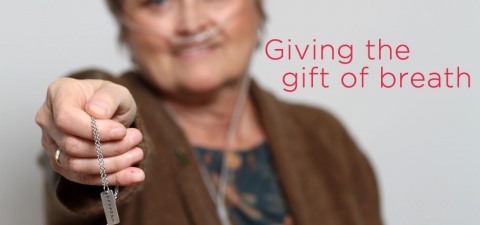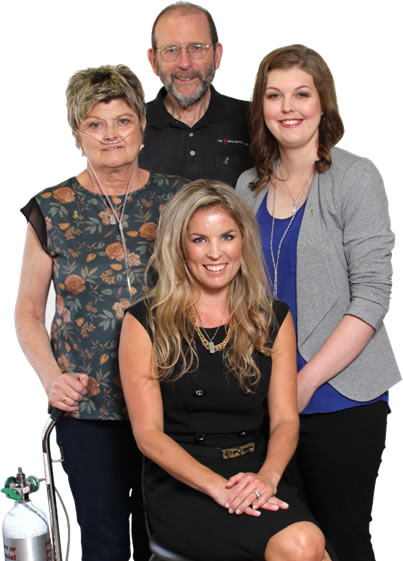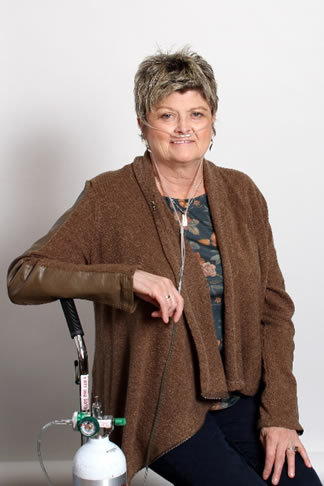September 22nd, 2016


Charlotte L’Oste-Brown, on Transplant Waitlist,
Dr. Brian Graham, CEO Lung Association,
Jill Hubick, RN, Lung Association,
Nicole Nelson, Double Lung Transplant recipient
Photo Credit: Sandy Lockhart Photography
For the people in our province suffering from severe lung disease, having a lung transplant may be their last and only option to survive.
Lung disease affects one in five Canadians and several of those lung diseases may lead to the need for a lung transplant.2 In fact every 15 minutes someone dies of lung disease in our country.3 The most common diseases for which lung transplant surgery is done include pulmonary fibrosis, chronic obstructive pulmonary disease (COPD), which includes chronic bronchitis and emphysema, and cystic fibrosis.1
Advances in treatment have made lung transplants possible for a greater number of patients. However, the demand and waitlist for donor organs are growing at a much faster rate than current organ donation rates and unfortunately diseases like COPD are also on the rise. In 2014, 226 lung transplants were performed in our country but 300 people remained on the waitlist and 70 people died while waiting for a transplant.6 In 2015 four Saskatchewan residents had lung transplants and ten remained on the wait list.13 The need for more organ transplantations will only increase in the future as the population ages.
The number of transplants done each year depends entirely upon the number of donor lungs that become available and the systems in place to support these procedures and patients. Canada’s donation rate is less than half of that of the best performing countries, and has plateaued over the last decade.9 Within Canada, Saskatchewan has one of the lowest donation rates. An average of four patients in Saskatchewan receive a lung transplant each year which represents approximately a third to one half of the patients in this province who are actively listed. Although medical care pre- and post-transplant is done in Saskatchewan, no lung transplant surgeries are done here and all patients needing this lifesaving procedure must travel out of province.11
“The process of being listed for and receiving a lung transplant is fraught with enormous stress and uncertainty for patients and their loved ones. Patients ask themselves, will I survive long enough to receive a transplant? Will an appropriate donor ever become available? Can I afford the costs of travel, medications, and time away from home?’ The costs are not only financial, but also emotional and psychological,” says Dr. Mark Fenton, Transplant Respirologist in the Division of Respirology, Critical Care and Sleep Medicine in Saskatoon.
 Nicole Nelson was told she had pulmonary fibrosis at just 18 years old. With a long-standing family history of an inherited form of pulmonary fibrosis, Nicole has lost 16 of her family members already to the disease.
Nicole Nelson was told she had pulmonary fibrosis at just 18 years old. With a long-standing family history of an inherited form of pulmonary fibrosis, Nicole has lost 16 of her family members already to the disease.
Because of her family history, Nicole was diagnosed in the early stages of the disease with few symptoms. However, in 2013 she noticed a rapid decline. In February of that year she caught a cold that she couldn’t seem to get over. She had a dry cough and shortness of breath and she found herself avoiding stairs, parking close to doors because walking far distances and activities that once seemed effortless were leaving her breathless.
In January 2014 Nicole attended a six week pre-transplant physiotherapy program which required her and a support person to move to Edmonton during that time. Unfortunately, due to financial reasons Nicole and her family could not afford to do this. In order to have another chance at life, she was forced to go on her own for six weeks and every weekend a different support person came to see her and help her with the assessments, physiotherapy, occupational therapy, and educational classes about the transplant.
“Everyone should speak with their families about organ and tissue donation because ultimately the families are the ones who make those lifesaving decisions.”
- Nicole Nelson,Double Lung Transplant Recipient
In July 2014 Nicole received her life saving call. She and her husband took an air ambulance to Edmonton where they both remained for another three months in order to recover from the transplant.
Today, Nicole describes receiving a donation as “a very humbling and expensive process.” She feels that the best way to increase the rate of organ donation is to increase the province’s awareness about the importance of organ donation. It is Nicole’s hope that organ and tissue donation will become a normal conversation among all families and those wanting to donate their organs and/or tissue have their intentions met. She also wants to see greater efforts among the health care system be taken to ensure health care providers are ready to respond to all donation opportunities and make the most of every suitable organ.
 Charlotte L’Oste-Brown is a mother of two that coached softball, sat on the local school board while owned and operated a 15,000 square foot greenhouse in her hometown of Hazemore, Saskatchewan for many years. In 2003 she was diagnosed with the terminal disease pulmonary fibrosis.
Charlotte L’Oste-Brown is a mother of two that coached softball, sat on the local school board while owned and operated a 15,000 square foot greenhouse in her hometown of Hazemore, Saskatchewan for many years. In 2003 she was diagnosed with the terminal disease pulmonary fibrosis.
Charlotte gradually stopped doing anything physical like cutting the grass, lifting objects, performing quick movements and enjoyable hobbies such as curling and dancing. As her disease progressed, she also had to give up her two-story home and her greenhouse. She now lives in room and board housing closer to medical services in Regina.
In the summer of 2014 her oxygen saturation dropped to 38% (normal is 98%) because of an infection and the thick smoke around Regina from forest fires at the time. Charlotte’s condition was serious and she was hospitalized. She has now been listed for transplant since December 1, 2015. Charlotte has to take immunosuppressants for her illness while she waits in hope of her life saving call. Each day she lives with caution and her greatest enemy, other than the pulmonary fibrosis itself, is infection. She describes the past few years as daunting, frustrating and stressful. She is attached to a 50 foot hose and has to go everywhere with oxygen. She goes to bed every night hoping she will make it through without choking. Then she starts each day wondering if today will be the day she gets her second chance at life.
“I am a real person not waiting for someone to die, but rather a woman who has no other choice but to wait for someone that has made the choice to give the gift of life.”
Charlotte L'Oste-Brown
(Waiting for new lungs)
She encourages everyone to “talk to their family about their wishes to become an organ donor today because people waiting may not have tomorrow.”
Jill Hubick, Registered Nurse with The Lung Association states that “the current process for organ and tissue donations allows the ability for the next of kin to override a donor sticker on a health card.” Hubick explains that “while some do attach an organ donor sticker to their health cards, what matters most is that people are actually able to fulfill their intention to become donors upon their deaths.”
On September 12, 2016 Dr. Mark Fenton, Nicole Nelson, Charlotte L’Oste-Brown, and Jill Hubick presented to the Legislative Assembly’s Standing Committee on Human Services with recommendations as to how the Government of Saskatchewan can increase the rate of organ donation and improve the effectiveness of the organ and tissue donation program in Saskatchewan.
Recommendations
- Consult/survey the people of Saskatchewan about the low rates of organ and tissue donation to determine strategies that will enhance public awareness and participation.
- Funds be allocated towards a robust organ and tissue donation campaign that debunks common myths and focuses on the essential need for all Saskatchewan residents to warrant that their intentions regarding organ and tissue donations are met.
- Ensuring that the system is ready to respond to all donation opportunities, and guaranteeing that the most is made of every potential donor organ by allocating necessary resources and appropriate management to understand and explore the medical and logistical reasons why donors/potential donors are missed in our province.
- Allotting funds to introduce a medical donation specialist, train and empower physicians, surgeons, and other health practitioners to do their part in identifying and referring potential donors. Allowing a complete culture shift within a patient –focused care system to ensure every member of the treatment team is aware of which patients may qualify to be organ and tissue donors.
- Dedicated funding for organ donation organization and direct funding from the Ministry of Health for all transplant-related activities that is independent of regional health authority budgets.
- Allocating funds specifically to support medical management of potential organ donors including an investment in support technologies for resuscitation of donor organs and bridging of recipients.
- Ensuring adequate and affordable housing accommodations are available close to treatment centers regardless of patient socioeconomic status.
- Safeguarding funding to support both the transplant recipient and their required support person for the additional costs they incur.
- Lung Association of Alberta. (2009). Lung Transplant Information for Alberta and NWT Residents. Retrieved on August 22, 2016 from https://www.ab.lung.ca/sitewyze/files/LungTransplant.pdf
- National Lung Health Framework. (2012). Frequently Asked Questions. Retrieved on August 25, 2016 from http://www.lunghealthframework.ca/about-framework/frequently-asked-questions
- Murray, C., Lopez, A. (1996). The Global Burden of Disease: A Comprehensive assessment of mortality and disability form diseases, injuries, and risk factors in 1990 and projected to 2020. Harvard University, Boston MA, USA and World Health Organization, Geneva, Switzerland.
- O’Donnell, D., Aaron, S., Bourbeau, J. et al. (2007). Canadian Thoracic Society: Recommendations for management of chronic obstructive pulmonary disease- 2007 update.
- Canadian Institute for Health Information. (2016). Organ Donations Continue to Fall Short of Meeting Demand. Retrieved on August 19, 2016 from https://www.cihi.ca/en/organ-donations-fall-short-of-meeting-demand
- Canadian Institute for Health information. (2015). Canadian Organ Replacement Register. Retrieved on August 25, 2016 from https://www.cihi.ca/en/infographic-organs-required-by-canadians-in-2014
- Cystic Fibrosis Canada. (2016). What is cystic fibrosis? Retrieved on August 22, 2016 from http://www.cysticfibrosis.ca/about-cf/what-is-cystic-fibrosis
- Pulmonary Fibrosis Canada. (2016). Understanding pulmonary fibrosis. Retrieved on August 25, 2016 from http://cpff.ca/understanding-pf/what-is-pulmonary-fibrosis/
- Canada's Organ and Tissue Donation and Transplantations Communities in Collaboration with Canadian Blood Services. (2008). Call to Action: A strategic plan to improve organ and tissue donation and transplantation performance for Canadians. Retrieved on August 25 from https://blood.ca/sites/default/files/otdt-indx-final-c2a.pdf
- Canadian Institute for Health Information. (2014). Lung Transplantation. Retrieved on August 22, 2016 from https://www.cihi.ca/en/corr2015_chap5_en.pdf
- Saskatoon Division of Respirology. (2016). Lung transplant data. August 24, 2016
- Rague, G., Collard, H., Egan J.et al. (2011). An official ATS/ERS/JRS/ALAT statement: idiopathic pulmonary fibrosis: evidence-based guidelines for diagnosis and management. American Journal of Respiratory Critical Care Medicine. 183(6), 788-824. Retrieved from http://www.atsjournals.org/doi/full/10.1164/rccm.2009-040GL#.V8mkOJgrI2w
- Alberta Heath Services. (2015). Lung transplant data. August 22, 2016
Photo Credit: Sandy Lockhart Photography
